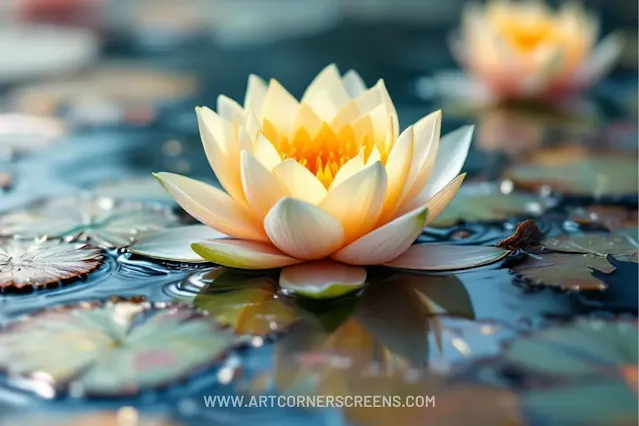 |
| Monet's Water Lilies |
Monet's Water Lilies: A Masterclass in Depth and Emotion
Claude Monet, the pioneering Impressionist, created a series of paintings that continue to captivate audiences and artists alike. Among his masterpieces, the Water Lilies series is an enduring testament to his brilliance. Beyond their tranquil beauty, these works reveal an intricate layering of techniques, emotions, and perceptions that reflect Monet's evolving relationship with nature, light, and artistic philosophy.
The Vision Behind Water Lilies
Monet's Water Lilies series began as a reflection of his idyllic garden in Giverny, which he cultivated meticulously as both a retreat and a source of inspiration. The pond, adorned with floating lilies and crossed by a Japanese bridge, became his primary muse. However, the paintings transcend mere representation.
Monet envisioned the Water Lilies series as an "illusion of an endless whole," capturing the flora and the interplay of sky, water, and reflection. The absence of a horizon line in many works disrupts the viewer's sense of orientation, immersing them in a dreamlike aquatic world.
Layering Techniques: The Secrets of Depth
Monet's innovative use of texture and color creates a multi-dimensional effect, immersing viewers in the serene yet dynamic aquatic world. His layering techniques evoke depth and movement, from delicate base washes to bold impasto strokes. This interplay of light, reflection, and form captures the ever-changing essence of nature.
A closer examination of Monet's Water Lilies reveals a mastery of layering achieved through technique and perspective.1. Physical Layers of Paint
Monet's brushstrokes in Water Lilies exhibit an extraordinary understanding of texture and movement. He layered paint with varying densities, often returning to canvases over weeks or months. Each layer serves a specific purpose, from establishing atmospheric tones to emphasizing the intricate details of the lilies and the rippling water. This careful technique creates a harmonious blend of depth and vibrancy, bringing the pond to life on the canvas.
- The base layer: Thin washes of color set the tone, imbuing the canvas with light and atmosphere.
- Mid-layers: Monet built depth using short, vigorous strokes to depict ripples, reflections, and shifting light.
- Final details: Thick dabs of impasto paint were added to the surface, bringing the lilies into focus. These heavier strokes create a tactile contrast, drawing the viewer's gaze to the serene floating blooms.
2. Layered Perceptions of Time
Monet was obsessed with capturing the passage of time, a hallmark of Impressionism. In Water Lilies, he often painted the same scene under different lighting conditions, such as morning mist, midday brightness, or the glow of twilight. These variations reveal a layered understanding of time, encouraging viewers to experience a static moment and the ebb and flow of natural rhythms.
3. Reflections and Transparency
Perhaps the most fascinating "layer" in Water Lilies is the optical interplay of reflection and transparency. The water acts as a mirror and a lens, reflecting the sky while revealing submerged vegetation. Monet depicted these dual realities with astonishing clarity, blending colors and forms to convey the fluidity of water.
For instance, the vibrant blues and greens of reflected trees merge seamlessly with the soft pinks and whites of the lilies. This interplay challenges viewers to see the world as Monet did: interconnected and ever-changing.The Emotional Layers of Water Lilies
Beyond its technical brilliance, Water Lilies resonates on a profoundly emotional level. Monet painted these works during a period of personal turmoil and eventual renewal. The series reflects Monet's journey through grief, with its tranquil scenes offering a sense of solace and healing.
The immersive compositions invite viewers to share in his meditative connection to nature. Each brushstroke becomes a testament to resilience, capturing fleeting beauty amidst life's uncertainties. Through Water Lilies, Monet transformed personal pain into universal serenity.
- Loss and Resilience: Monet began the series shortly after the death of his wife, Camille, and during his own struggles with deteriorating eyesight. The paintings reflect his grief and determination to find solace in nature.
- Meditative Quality: The expansive canvases, some spanning over 20 feet, were designed to envelop the viewer, creating a contemplative space. This immersive quality invites contemplation, echoing Monet's own search for peace.
The Influence of Water Lilies
Monet's Water Lilies revolutionized modern art, influencing movements like Abstract Expressionism. Artists such as Mark Rothko and Jackson Pollock drew inspiration from Monet's focus on atmosphere and the dissolution of form. In a contemporary context, these paintings inspire digital artists, whose layered compositions often reflect Monet's innovative techniques.
Hidden Details in Water Lilies
Every viewing of Water Lilies reveals new surprises, thanks to Monet's intricate layering. The subtle interplay of colors and textures invites deeper exploration with each glance. Hidden reflections, delicate brushstrokes, and shifting light continuously evolve the viewer's perception. Monet's layered approach ensures the painting remains dynamic, uncovering fresh details each time. Look closely, and you might notice:
- Subtle shifts in color: Monet often used complementary colors to heighten the visual tension between elements, such as the cool blues of water contrasting with the warm oranges of reflected sunlight.
- Delicate imperfections: Leaves and flowers are rarely depicted with photographic precision, emphasizing nature's fleeting and imperfect beauty.
- The illusion of motion: The brushstrokes themselves seem to ripple, capturing the dynamism of water.
A Timeless Masterpiece
Claude Monet's Water Lilies series is not merely a set of paintings; it represents a deep investigation of nature's visible and invisible aspects. Utilizing innovative techniques, Monet encourages us to look past the surface and interact with the complex dynamics of light, reflection, and emotion. Whether experienced in a museum or through high-definition digital reproductions, the timeless allure of these masterpieces endures. Monet's textured methodology inspires thought, demonstrating that authentic art surpasses time and medium.
This post is designed for the Artwork Analysis section of Art Corner Screens. It explores the techniques and emotions behind Monet's iconic Water Lilies, encouraging you to deepen your appreciation for the many layers of art.

